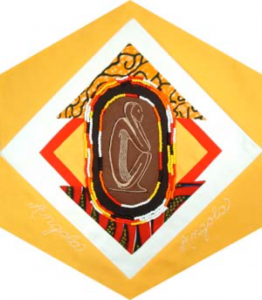Angola

The Block
This block, designed by Isabel Nzuzi Sebastiao, is an embroidered and quilted rendering of the renowned Angolan statue, O Pensador (the Thinker). The statue, a wonderful example of traditional Chokwe (an Angolan ethnic group) craftwork, sits in a comfortable cross-legged position cradling its head between both hands and one cannot help but wonder what mystery of life it may be pondering. In the village of Chokwe, it is believed that O Pensador gives forth a positive energy, which is absorbed by the people and protects them. The block’s image is surrounded by colourful beads, like those often worn as accessories in Angola. It is accentuated on a background of easily recognizable fabrics and patterns of Angolan cloth. In Angola, subtle differences in clothing, such as the colours, patterns and even the style in which garments are worn, communicate the origin of the wearer.
Cultural Profile
Angola lies along the southwest coast of Africa. Its name, derived from the Bantu word ngola, the title given to the kings of Ndongo, a territory located in parts of what is today Angola. This kingdom came under Portugese rule in the 16th century. In the 1670s it became known as Portuguese West Africa. The Republic of Angola was constituted in 1975, but many years of civil unrest ensued until a ceasefire was agreed upon in 2002. The country includes Cabinda Province, an enclave that is separated from the rest of the country by the Democratic Republic of the Congo. Angola is an interesting fusion of indigenous and Portuguese cultural influences, especially in cities, where local languages tend to give way to Portuguese, the country’s official language. The vast majority (95%) of Angolans belong to ethnic groups that speak languages categorized under the Bantu language family.
Angolan artwork includes textiles and ceramics which often use geometric and abstract designs to depict scenes of daily life. Sculptures and masks are prominent artforms, created in a variety of mediums, such as wood, bronze, ivory, malachite and ceramic. Each ethnic group has its own unique style of carving and sculpting. The Chokwe people, for example, are well-known for their wooden masks and statues, which are often carved in the images of mythological gods. The masks are much more than artistic expressions; they represent life’s major transitions and are frequently used in complex cultural rituals that mark these transitions. Carved masks are also a major part of Angola’s thriving handicraft industry.
Traditional headdresses and necklaces worn by Angolan women can be elaborate and fascinating to outsiders. Made in part of the type of beads found on the block, they are extremely heavy. Usually these headdresses and necklaces cannot be taken off once they are put on. They are modified and made more complex with each major event in the woman’s life.
Angola’s music is varied as a result of many influences. Semba is a more traditional type of music and dance, and its resemblance to the samba is no coincidence: semba indeed morphed into samba after it crossed to Atlantic to another Portuguese colony, Brazil. The kizomba, a genre relating to zouk, semba and compa, is sung in Portuguese and is popular not only in Angola, but in all Lusophone countries.The influences of Europe can be heard in the rebita, where African drums provide a lively background to the accordion and harmonica, while energetic kuduro is a more urban, contemporary, style of dancing and singing.
Angolans continue to treasure and share their cultural heritage wherever they live in the world. As of 2011, Angolan immigrants to Canada numbered approximately 1,900.
Sponsor: Alan Sullivan
